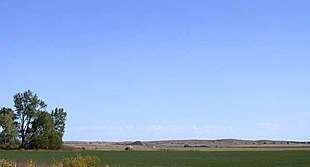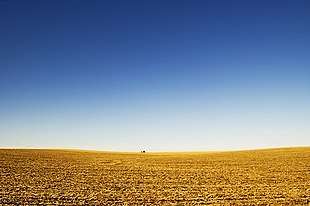Prairie madness
Prairie madness or prairie fever was an affliction that affected settlers in the Great Plains during the migration to, and settlement of, the Canadian Prairies and the Western United States in the nineteenth century. Settlers moving from urbanized or relatively settled areas in the East faced the risk of mental breakdown caused by the harsh living conditions and the extreme levels of isolation on the prairie. Symptoms of prairie madness included depression, withdrawal, changes in character and habit, and violence. Prairie madness sometimes resulted in the afflicted person moving back East or, in extreme cases, suicide.
Prairie madness is not a clinical condition; rather, it is a pervasive subject in writings of fiction and non-fiction from the period to describe a fairly common phenomenon. It was described by Eugene Virgil Smalley in 1893: "an alarming amount of insanity occurs in the new Prairie States among farmers and their wives."[1][2]
Causes
Prairie madness was caused by the isolation and tough living conditions on the Prairie. The level of isolation depended on the topography and geography of the region. Most examples of prairie madness come from the Great Plains region. One explanation for these high levels of isolation was the Homestead Act of 1862. This act stipulated that a person would be given a tract of 160 acres if they were able to live on it and make something out of it in a five-year period. The farms of the Homestead Act were at least half a mile apart, but usually much more.[1] Although there were thriving Indigenous nations and communities, there was little settlement of Europeans on the Plains and settlers had to be almost completely self-sufficient.
The lack of quick and easily available transportation was also a cause of prairie madness; settlers were far apart from one another and they could not see their neighbors or get to town easily. (In many areas, towns were usually located along the railroads and 10-20 miles apart -- close enough for people to bring their goods to market within a day's travel, but not close enough for most people to see town on more than an infrequent basis. This particularly applied to women who were often left behind to tend to family and farm while the men went to town.) Those who had family back on the East coast could not visit their families without embarking on a long journey. Settlers were very alone. This isolation also caused problems with medical care; it took such a long time to get to the farms that when children fell sick they frequently died. This caused a lot of trauma for the parents, and contributed to prairie madness.
Another major cause of prairie madness was the harsh weather and environment of the Plains, including long, cold winters filled with blizzards followed by short, hot summers. Once winter came, it seemed that all signs of life such as plants, and animals had disappeared. Farmers would be stuck in their houses under several feet of snow when the blizzards struck, and the family would be cramped inside for days at a time.[3] There were few trees, and the flat land stretched out for miles and miles. Some settlers specifically spoke of the wind that rushed through the prairie, which was loud, forceful, and alien compared to what settlers had experienced in their former lives.[1]

Risk factors
Many stayed very attached to their way of life back East, and their attempts to make their new homes in the West adhere to the old ways sometimes triggered prairie madness. Others tried to adapt to the entirely new way of life, and abandoned the old ways, but still fell victim to madness. Some coping mechanisms to escape the emotional trauma of moving to the prairie was to continually move around to new locations, or to move back East.[3]
Immigrants were particularly at risk for prairie madness. Immigrant families not only had to suffer from isolation, but the settlers who lived in their area often had different languages and customs. As such, this was an even further separation from society. Immigrant families were also hard-hit by prairie madness because they came from communities in Europe that were very close-knit small villages and life on the prairie was a terrible shock for them.[1]
There is a debate between scholars as to whether the condition affected women more than men, although there is documentation of both cases in both fiction and non-fiction from the nineteenth century. Women and men each had different manifestations of the disease, women turning towards social withdrawal and men to violence.[3]
Symptoms

Since prairie madness does not refer to a clinical term, there is no specific set of symptoms of the affliction. However, the descriptions of prairie madness in historical writing, personal accounts, and Western literature elucidate what some of the effects of the disease were.
The symptoms of prairie madness were similar to those of depression. The women affected by prairie madness were said to show symptoms such as crying, slovenly dress, and withdrawal from social interactions. Men also showed signs of depression, which sometimes manifested in violence. Prairie madness was not unique from other types of depression, but the harsh conditions on the prairie triggered this depression, and it was difficult to overcome without getting off of the prairie.[3]
In extreme cases, the depression would lead to mental breakdown. This could lead to suicide. There are theories that the suicides caused by prairie madness were typically committed by women, and performed in an exhibitionist fashion. Prairie madness did not typically lead to suicide, and this is depicted more in fictional stories than it is seen in the historical record.[3]
Decline
Prairie madness virtually disappears from the historical and literary record during the 20th century. This was likely the result of new modes of communication and transportation that arose during the late 19th and early 20th century. These included the increase in railroad lines, the invention and increasing usage of both the telephone and automobile, and further settlement leading to the "closing of the frontier", as described by renowned American Western historian Frederick Jackson Turner.[1]
In popular culture
- Thomas Mayne Reid in his novel written in the first person voice and set in northern Mexico, The Scalp Hunters: or, Romantic Adventures in Northern Mexico (1851)[4] used the expression "prairie fever" in the words of the narrator to convey the enchantment with the freedom of prairie life:
... with gallops by day and the wilder tales by the night watch-fires, I became intoxicated with the romance of my new life. I had caught the "prairie-fever!" So my companions told me, laughing. I did not understand them then. I knew what they meant afterwards. The prairie fever! Yes. I was just then in process of being inoculated by that strange disease. It grew upon me apace. The dreams of home began to die within me; and with these the illusory ideas of many a young and foolish ambition.[5]
- Stephen Bridgewater directed in 2008 an American Western film, Prairie Fever, starring Kevin Sorbo, Lance Henriksen and Dominique Swain.
- Peter Pagnamenta published a non-fiction book, Prairie Fever: British Aristocrats in the American West, 1830-1890 in 2012.[6]
- Glendon Swathout's novel (also adapted to film), "The Homesman", showcases prairie madness.
- Michael F. Parker wrote a novel, Prairie Fever in 2019.[7][8]
- Annika Barranti Klein published a story, "Prairie Fever" in CRAFT Literary in January 2020.[9]
- James Michener covers the topic of mental health in one of the chapters about the settlement of the Colorado Plains in his opus Centennial.
See also
References
- Boorstin, D. (1973). The Americans: The Democratic Experience. New York: Random House. pp. 120–125.
- Rich, N. (12 July 2017). "American Dreams: O Pioneers! by Willa Cather". The Daily Beast. Retrieved 26 October 2019.
- Meldrum, B. H. (1985). "Men, Women, and Madness: Pioneer Plains Literature". Under the Sun: Myth and Realism in Western American Literature. Troy: Whitson Publishing. pp. 51–61.
- Capt. Mayne Reid. The Scalp Hunters: or, Romantic Adventures in Northern Mexico. London: C. J. Skeet, 1851. 3 volumes. (First Edition)
- Mayne Reid. The Scalp Hunters, ch. III, The Prairie Fever.
- Pagnamenta, Peter. Prairie Fever: British Aristocrats in the American West, 1830-1890. New York, NY: W. W. Norton & Company, 2012. ISBN 0393072398
- Prairie Fever: New novel coming May 2019 from Algonquin Books
- Parker, Michael. Prairie Fever. Chapel Hill, NC: Algonquin Books, 2019
- Klein, Annika Barranti. Prairie Fever by Annika Barranti Klein, CRAFT Literary, 2020
